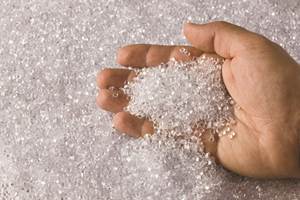Seven-Layer R&D Line Spurs Blown Film Innovation
Business might be slow in most blown film extrusion markets, but leading-edge processors are preparing for better times by tapping into a seven-layer line installed last year at Dow Chemical Co.’s Film Application Development Center (FADC) in Freeport, Tex.
Business might be slow in most blown film extrusion markets, but leading-edge processors are preparing for better times by tapping into a seven-layer line installed last year at Dow Chemical Co.’s Film Application Development Center (FADC) in Freeport, Tex. The line was part of Dow’s $5.2 million expansion of its FADC.
The line, furnished on a turnkey basis by Hosokawa Alpine American, Natick, Mass. (halpine.com), went up in February 2009. It was unveiled publicly during June’s NPE 2009 show in Chicago, when live demonstrations were shown on screens in Alpine’s booth.
Since the 2009 installation, Dow (plastics.dow.com) has had roughly 45 different customers in for more than 100 trials, says Greg Bunker, lead development specialist. “We’re not talking about a lab line here, but a full-scale production line that permits processors to produce commercial-grade film, allows them to experiment, to invent,” Bunker notes. Dow’s investment came during what has been perhaps the film industry’s worst economic slump ever. And it suggests that one way processors can emerge from it is to innovate.
“Customers who have come in to use the equipment run the gamut from those who are more familiar with monolayer production to ones with three-layer capacity who are looking to jump to more complex five- to seven-layer structures,” says Bunker. More than one processor has used the line for a short run of a brand-new film in order to “seed the market” with commercial-grade product to gauge customer reaction without occupying its own production equipment.
Confidentiality agreements preclude Dow from divulging who is making what on this line. “But we’re seeing things that have never been done before, both in the way of film structures and material combinations and penetration into new markets,” Bunker says.
The Alpine line has seven 50-mm, grooved-feed extruders with 30:1 L/D. It is equipped Alpine’s patented X die, which is designed to eliminate port lines. Dow has 200- and 250-mm die inserts. Bunker remarked on how quickly the die purges, which is critical where product changeovers are
the norm and setup time must minimized. Film gauge is regulated by Alpine’s segmented air ring. The line is also furnished with Alpine’s Resin Miser control system. Bunker says the fastest Dow has run the line is at 20 lb/in. of die circumference, though that is not the limit. Alpine says the line is rated at 1000 lb/hr.
Some of what Dow has run in Freeport are these structures:
- Four-mil-thick, three-layer structures for shipping sacks, the core of which is its high-melt-strength Inspire HMS PP.
- A 7-layer, 4-mil barrier film featuring Dow’s latest offering in the Dowlex LLDPE resin family, XUS 61530.04.
- Two-layer, 2-mil film for cookies, crackers, and other dry-food applications. The key material is Dow’s Elite 5960G enhanced PE.
- A 5-layer, 2.5 mil, high-clarity lamination sealant film for food packaging. Dow’s Elite 5940 provides clarity, stiffness and toughness to the film as the B component of the A/B/C/D structure.
- Three-layer, 4-mil stretch-hood film, run in an ABC formulation. A core layer of Dow’s Affinity polyolefin plastomer blended with Dow 1321 LDPE is sandwiched between a developmental Dowlex NG LLDPE grade, XUS 61530.02.
Related Content
Delivering Increased Benefits to Greenhouse Films
Baystar's Borstar technology is helping customers deliver better, more reliable production methods to greenhouse agriculture.
Read MoreApril 2025: Mixed Bag for Prices of Volume Resins
The end of the first quarter marked higher prices for polyolefins and relatively flat pricing for nearly all other resins.
Read MoreFundamentals of Polyethylene – Part 3: Field Failures
Polyethylene parts can fail when an inappropriate density is selected. Let’s look at some examples and examine what happened and why.
Read MorePrices Drop for All Five Commodity Resins
While PE price reductions were not as apparent, they too were following the year-end price trajectory of PP, PS, PVC and PET.
Read MoreRead Next
Lead the Conversation, Change the Conversation
Coverage of single-use plastics can be both misleading and demoralizing. Here are 10 tips for changing the perception of the plastics industry at your company and in your community.
Read MoreMaking the Circular Economy a Reality
Driven by brand owner demands and new worldwide legislation, the entire supply chain is working toward the shift to circularity, with some evidence the circular economy has already begun.
Read MoreBeyond Prototypes: 8 Ways the Plastics Industry Is Using 3D Printing
Plastics processors are finding applications for 3D printing around the plant and across the supply chain. Here are 8 examples to look for at NPE2024.
Read More














